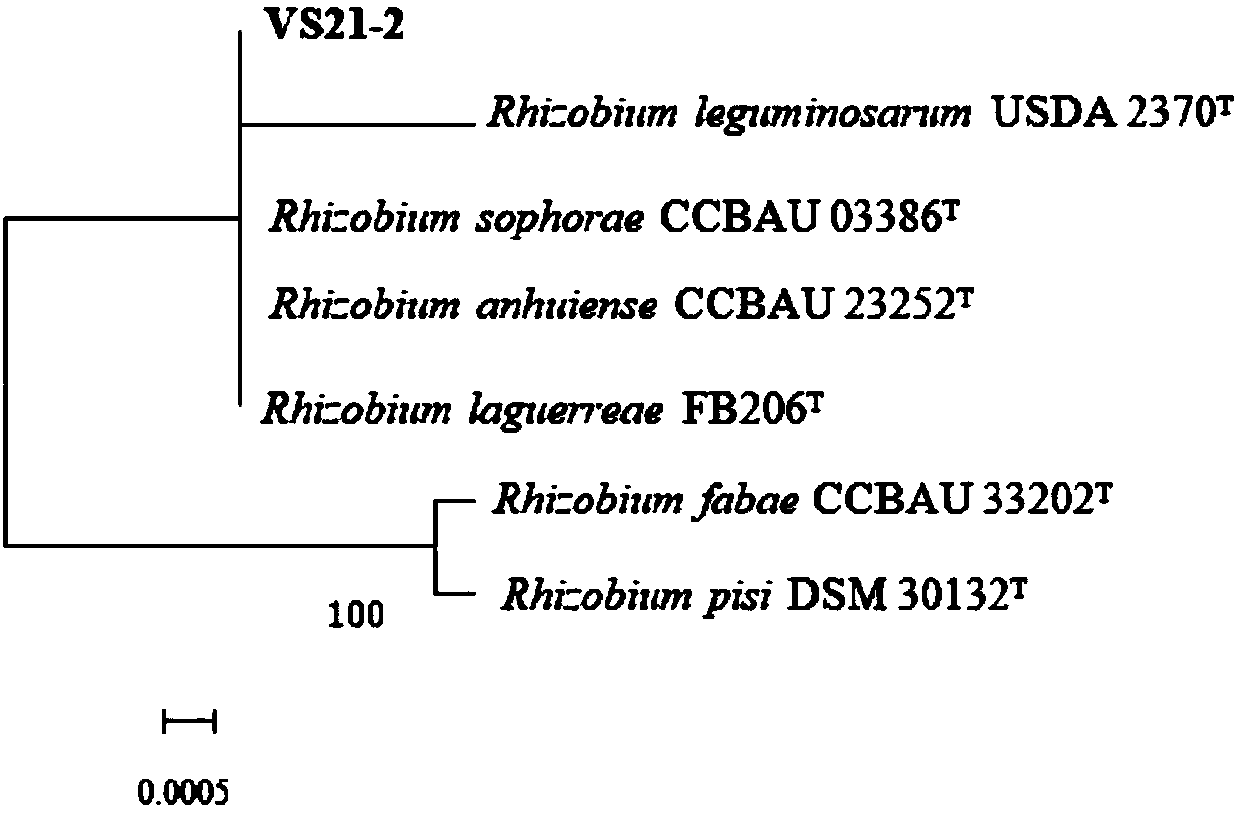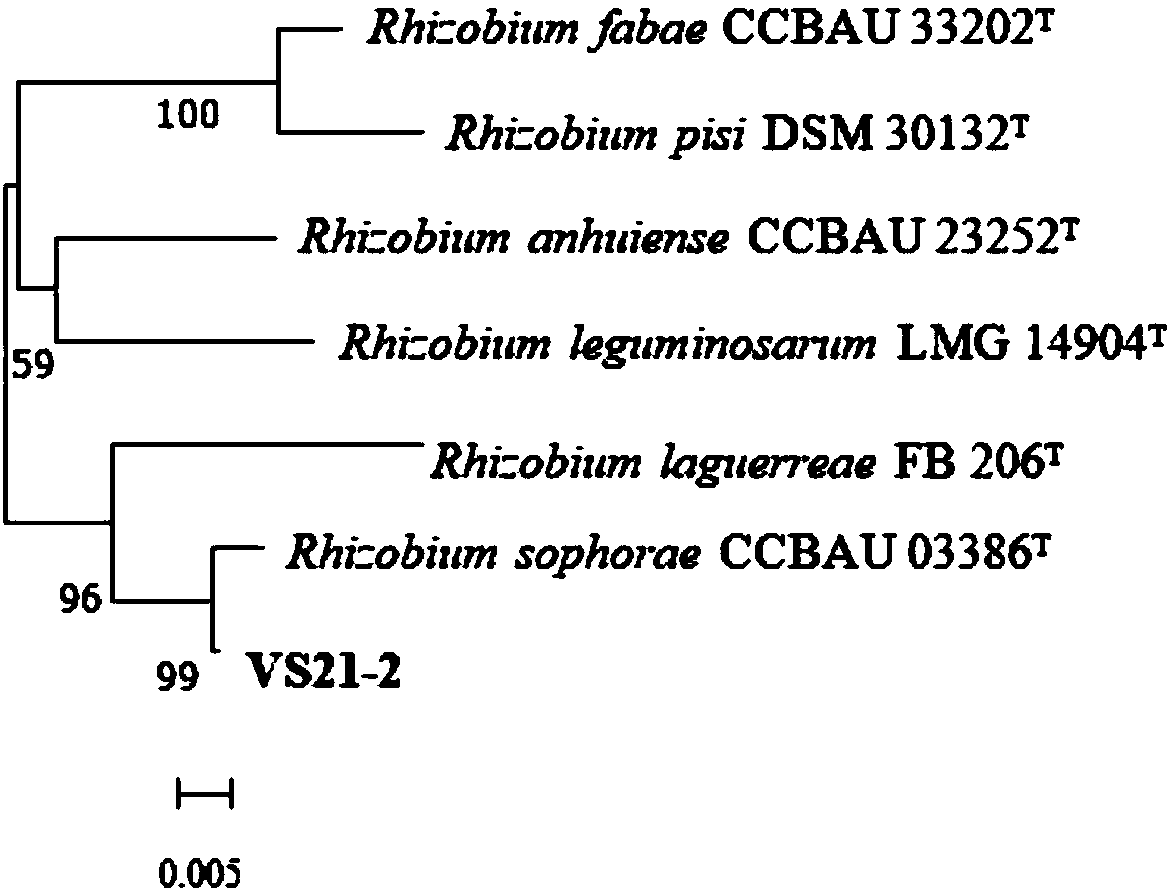Vicia sativa rhizobium strain VS21-2 and application thereof
A technology of arrow pea and rhizobia, which is applied in the field of microorganisms to achieve the effect of obvious yield increase, strong nitrogen fixation ability and good affinity
- Summary
- Abstract
- Description
- Claims
- Application Information
AI Technical Summary
Problems solved by technology
Method used
Image
Examples
Embodiment 1
[0015] Example 1 Isolation, purification and storage of Rhizobium vulgaris VS21-2
[0016] From wild arrow pea collected from Xiangshui Village, Yanjiang Town, Yanjiang District, Ziyang City, Sichuan Province, choose strong plants with large and full red nodules on the main roots, wash the nodules, take part of the root bark off, and perform surface disinfection: use 95% Soak in ethanol for 5 minutes to eliminate the surface tension, then disinfect the surface with mercury (0.1% m / v) for 5 minutes, and finally rinse with sterile water 6-8 times. Put the nodules on a sterilized white porcelain plate in a sterile environment, use bamboo sticks to break the nodules and smear them on a plate of YMA medium, carry out streaking purification, and cultivate in a 28°C incubator. YMA medium formula: KH 2 PO 4 0.25g, MgSO 4 ·7H 2 O 0.2g, CaCl 2 ·6H 2 O0.1g, NaCl 0.1g, ammonium molybdate (1%) 2mL, boric acid (1%) 2mL, Congo red (1%) 2.5mL, mannitol 10g, yeast powder 0.8g, agar 18-20g, water...
Embodiment 2
[0019] Example 2 Rhizobium back joint test
[0020] The back inoculation test of rhizobia used sand culture method. The arrow pea species used in the experiment was Northern Sichuan arrow pea, which originated from Xiangshui Village, Yanjiang Town, Yanjiang District, Ziyang City, Sichuan. It was carried out in a light room (temperature controlled 22-24°C, light intensity about 2800 lux, sunshine time 14h), planted 46d and harvested. Regularly supplement the sterilized nitrogen-free nutrient solution, and inoculate Rhizobium versicolor VS21-2 into the sand culture vessel. The sand culture device uses a 300mL plastic cup, and the substrate is vermiculite, so that Rhizobium versicolor VS21-2 is not inoculated. The plant of the same product was the control CK, and each treatment was repeated three times. After harvest, the number of nodules and the dry weight of the pea plant were used to evaluate the inoculation effect of Rhizobium vulgare VS21-2.
[0021] (1) Bacterial liquid cultu...
Embodiment 3
[0031] Example 3 The resistance ability of Rhizobium sagittatum VS21-2
[0032] The resistance to stress of Rhizobium sagittatum VS21-2 was mainly tested for salt tolerance and acid and alkali tolerance. The YMA medium was used as the basic medium, and the YMA plates cultured at pH 7, 28°C for 7 days were used as positive control (CK). The above-mentioned YMA slant culture of Rhizobium sagittatum VS21-2 was scraped with sterile water to prepare a bacterial suspension for use. The spot inoculation method was adopted, and each treatment was repeated 3 times. The plates for acid and alkali resistance and salt resistance tests were all incubated at 28°C for 3 days and the recorded results were observed.
[0033] (1) Medium formula for acid and alkali resistance determination: use YMA medium as the basic medium, adjust the pH value with HC1 and NaOH, so that the pH value of the medium is 4.0, 5.0, 6.0, 8.0, 9.0, 10.0, 11.0 .
[0034] (2) Medium formula for salt tolerance determination...
PUM
| Property | Measurement | Unit |
|---|---|---|
| particle diameter | aaaaa | aaaaa |
Abstract
Description
Claims
Application Information
 Login to View More
Login to View More - R&D Engineer
- R&D Manager
- IP Professional
- Industry Leading Data Capabilities
- Powerful AI technology
- Patent DNA Extraction
Browse by: Latest US Patents, China's latest patents, Technical Efficacy Thesaurus, Application Domain, Technology Topic, Popular Technical Reports.
© 2024 PatSnap. All rights reserved.Legal|Privacy policy|Modern Slavery Act Transparency Statement|Sitemap|About US| Contact US: help@patsnap.com










